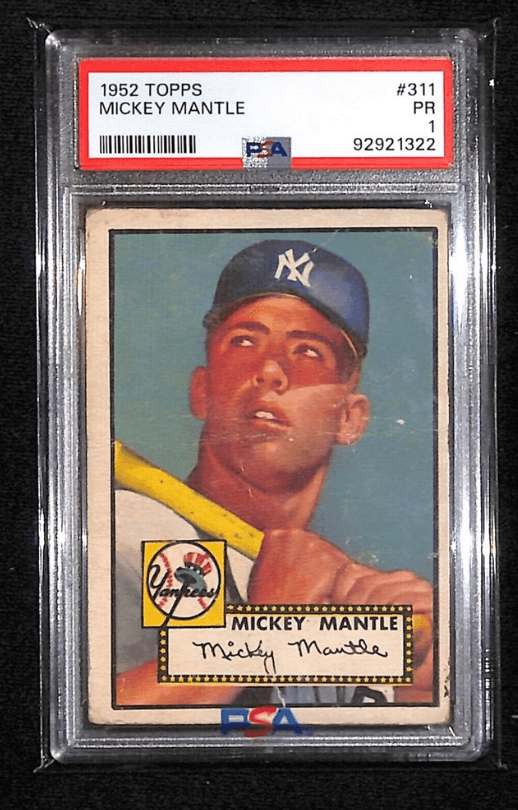PSA Grading Guide: How to Get Your Cards Graded

Wondering if your trading cards are worth thousands? Here’s how PSA grading answers that question and where you can get your cards graded without breaking the bank.
Did you hear about that ripped Honus Wagner card that sold for $475k?
“Cards featuring a player’s rookie season, like a Michael Jordan 1986 Fleer Rookie in PSA 10 condition, can sell for around $700,000, making them prime candidates for grading.”
Well, the most surefire way to figure out what your cards are worth is to get them graded. But as you’ll soon learn, PSA grading takes time and moolah. In this article, we’ll go over what PSA grading is and how it works. And to Topps it all off, I’ll introduce you to the most hassle-free and affordable card grading service on the market today. So batter up.
What is PSA grading?
Trading cards have evolved from childhood hobbies to serious investments, becoming a billion-dollar industry and store of value. With this rise, card grading services emerged to ensure authenticity and protect and boost the value of these prized collectibles.
For collectors, getting their cards graded by PSA (Professional Sports Authenticator) elevates the hobby to such a serious stage, where the card’s condition, rarity, and desirability can dramatically impact its value and marketability.
PSA is widely regarded as a respected universal grading standard, having authenticated and graded over 40 million sports cards, worth over $1 billion. That’s not just a number; it’s proof of the trust collectors place in PSA when determining a card’s value and condition. In fact, cards certified and graded by PSA achieve amazing prices at auction.
While other grading services like Beckett and SGC offer viable alternatives, PSA’s unmatched reputation and thorough grading process have made it the first choice for many collectors.
New to grading? For a limited time only, get up to $25 off your first online grading order. Use our link here and make sure you enter the promotional code MONEYMADE25 on the Shipping/Billing screen to receive the discount.
The PSA grading scale
What do all those PSA grades really mean? Well, they’re more than just numbers; they represent the condition and desirability of your card and are a huge indicator of its value. PSA assigns grades on a 1-to-10 scale, with each level indicating a specific quality.
Here’s a quick breakdown of the PSA grading scale:
GEM-MT 10 (Gem Mint) | This is the holy grail of trading card grades. A PSA 10 indicates a card that is virtually perfect—four perfectly sharp corners, flawless edges, and pristine centering. | The highest possible grade indicates a card in an essentially perfect state. |
MINT 9 (Mint) | Just a hair away from perfection, a PSA 9 card might have tiny imperfections, such as a slight surface flaw, a minor printing blemish, or a slightly off-center card. However, it’s still in excellent shape, making it highly desirable, especially for newer cards. | Cards in this grade are highly desirable and in excellent condition, with only minor imperfections. |
NM-MT 8 (Near Mint-Mint) | Cards in this category are still considered of good quality but may have minor issues, such as slight centering problems, subtle edge wear, or slight surface wear. | Considered near the top quality with only minor visible issues. |
NM 7 (Near Mint) | A PSA 7 can show some visible flaws—like minor corner wear or poor centering that impact the overall balance of the card—but it’s still a great card to own, especially for vintage items. | Visible flaws are present, but it maintains a generally good aesthetic appeal, especially for vintage cards. |
EX-MT 6 to VG 3 (Excellent-Mint to Very Good) | These cards will show more noticeable wear, including soft corners, surface scratches, or edge issues. | These grades indicate that cards show more noticeable wear yet can be highly valued, particularly when vintage. |
GOOD 2 to PR 1 (Good to Poor) | Surprisingly, even low-graded cards can be valuable. These cards may have serious damage, such as creases, discoloration, or rounding corners, but their value often lies in their scarcity and backstory, such as a 1909-11 T206 Honus Wagner PSA 1 card that sold for millions. | Despite serious damage, scarcity and backstories can make even low-graded cards very valuable. |

The PSA Photograde tool shows the visual differences between each PSA grade.
Source: PSA Photograde
PSA also offers a photograde tool that lets you visually compare the differences between these grades, which can help spot the condition of your own cards. The higher the PSA grade, the more pristine a card’s condition is.
PSA determines centering, corners, edges, and surface quality as the four key factors influencing a card’s grade. Cards with perfect centering, crisp corners, smooth edges, and no surface defects typically receive higher grades.
But it’s not just about the grade alone. Rarity and popularity are just as important. A rare card with a low population, like the Mickey Mantle #311, can skyrocket in value even if it’s not in perfect condition.
However, the reverse is also true. A common card with a high percentage of PSA 10 grades may not be worth much simply because plenty of perfect-condition cards are available.
How PSA grading works
If you’re wondering how to get cards graded, PSA offers three options to submit your cards:
- Option 1: High-value items can be dropped off at PSA’s Woodbridge, NJ office on a case-by-case basis.
- Option 2: You can submit your cards at a PSA-attended trade show, which is convenient if you’re already attending one.
- Option 3: PSA’s Online Submission Center is the most popular option, where you fill out the necessary forms and ship your cards directly to their facility.
Once your cards arrive at PSA, the process is impressively thorough. Each package is opened under a camera to ensure the contents match the submission forms. This added layer of security ensures that every card is tracked from the moment it arrives.
Next, your cards are examined to confirm they are genuine. Cards pass through a series of checks to verify their authenticity, including layers, edges, and printing.
The actual grading process is just as meticulous. PSA graders assess cards based on four key factors: centering, corners, edges, and surface condition. Special tools, like a centering scale, ensure accurate measurements to give each card the fairest grade possible.
Once graded, each card is sealed using ultrasonic welding, ensuring a tamper-proof and safe encasement.
If you choose to submit your cards online for grading, here are the steps involved:
1. Select a PSA service level & pricing
Once you’ve completed your PSA submission form, you’ll need to select a service level, which determines the PSA grading cost. Grading PSA cards involves different pricing tiers based on the card’s declared value and your preferred turnaround time.
Typically, the higher the card’s value, the more it will cost to get graded—and the faster the turnaround time if you opt for higher-tier services.
Here’s a quick breakdown of common PSA service levels:
Value (Bulk) | $15–$20 | Up to $199 | 120 – 150 days |
Regular | $75 | Up to $1,499 | 60–90 days |
Express | $150 | Up to $2,499 | 30–45 days |
Super Express | $300 | Up to $4,999 | 5–10 days |
Walk-Through | $600+ | $5,000+ | 1–2 days |
Pricing examples:
- Modern cards (e.g., Pokémon, Sports): If you’re grading a modern Pokémon card worth around $200, the Value service level, which costs around $20 per card, is likely your best option. This is perfect for bulk submissions and lower-value cards.
- Vintage cards: For vintage cards with an estimated value of $1,000, the Regular service at $75 per card is more appropriate. This gives you a moderate turnaround time without breaking the bank.
Handling higher-value cards
For cards worth $1,500 or more, you’ll need to consider higher service levels like Express or Super Express. These options come with faster turnaround times, which can be crucial for high-ticket items, especially if you plan on selling them soon after grading.
For cards worth over $5,000, the Walk-Through service offers the fastest grading option. It ensures that your valuable cards are graded and returned within days.
If you’re unsure about your cards’ value, PSA provides helpful resources like its Price Guide, Auction Prices Realized, and Population Report. You can also contact a local dealer for assistance in valuing your collection.
2. Ship your cards to the PSA facility
When shipping your cards to PSA, it’s important to remember a few best practices to ensure they arrive safely and securely.
Packing your cards for shipping
First, you’ll want to pack your cards to minimize movement during transit. Here are a few tips to help you do that:
- Penny sleeves & card savers: Start by placing your cards in penny sleeves, which are thin protective sleeves designed to fit trading cards. Next, use a card saver (preferably Card Saver 1 or 2), which adds a layer of rigidity without being too bulky.
- Team bags (optional): For extra protection against dust or debris, consider sealing the cards inside team bags before placing them in the card savers.
- Secure in cardboard: Once the cards are in their card savers, sandwich them between two pieces of cardboard that are slightly larger than the cards themselves. This will provide extra protection against bending.
- Bubble wrap and box: Wrap the card bundle in bubble wrap and place it in a sturdy, appropriately sized box. Ensure there’s no room for the cards to shift around during shipping. A medium flat-rate box is often a good choice for most submissions.
Insure your shipment
The declared value you provide on the PSA form will be used for insurance in case of damage or loss during shipping. So, it’s crucial not to understate the value of your cards. If you’re submitting cards worth up to $199, ensure your package is insured for that amount. You’ll want to adjust the insurance based on their declared value for higher-value cards.
For example, if you’re submitting cards with a declared value of $2,000, you’ll need a shipping insurance policy that covers at least that amount to protect your investment.
Shipping timeframes & methods
While PSA turnaround times depend on your chosen service level, shipping times can vary. Domestic shipments usually take a few days to reach PSA, depending on your carrier (USPS, FedEx, etc.). Ensure your package has a tracking number and sufficient insurance for smooth delivery.
For international collectors, customs delays are a potential issue. Packages going through customs may experience additional processing time, especially if the declared value raises any flags. To avoid unnecessary delays, clearly label your package as containing collectible cards and ensure all paperwork is filled out correctly.
PSA’s most basic service level costs $20/card, with a minimum submission of 20 cards worth up to $199 in declared value. On the other hand, their most elite service costs $600/card, worth up to $9,999 in declared value. What’s more, the PSA grading process can take anywhere from a week or so to 150 days.

PSA services & pricing
Source: PSA
Once your card arrives at the PSA facility, an entire team of experts will closely inspect it and apply the 1-10 PSA grade to each item. Then, the PSA encapsulates each card in a tamper-evident holder with a label that identifies it by its issue date, manufacturer, number, subject, and PSA grade.
The label also includes the PSA holographic logo, fugitive ink to prevent tampering, a certificate number, and a QR code to confirm authenticity.

Each PSA-graded card comes sealed with a holographic logo, fugitive ink, a unique certificate number, and a QR code for verification.
Source: PSA
3. Receive your PSA-graded cards in the mail
You’ll eagerly await their return once your cards have gone through the grading process. However, there are times when PSA may reject a card, deeming it ungradable. Understanding the reasons behind these rejections can help you avoid costly mistakes.
Common reasons for rejection
Recoloration: Collectors or sellers may attempt to “restore” cards by using markers or other coloring tools to cover up damaged areas. For example, a first edition Blastoise was famously rejected by PSA because someone used a blue marker to fill in nicks on the back of the card. While the card itself was genuine, the tampering rendered it ungradable. PSA strictly rejects any cards that have been altered in this way.

Blastoise filled in with a blue marker at the back of the card.
Source: YouTube: Collectors Impact
Trimming: Another common issue is trimming, where a card’s edges are deliberately cut to remove signs of wear, such as frayed edges or minor damage. This tactic is often used on vintage cards in an attempt to make them appear in better condition. A notable case involved a Zion Williamson sports card that PSA rejected for this very reason. PSA uses precise tools to measure the dimensions of each card, and any discrepancy will raise a red flag.
Counterfeits: Fake cards are a major problem in the trading card industry. While not as common, counterfeit cards are usually detected through PSA’s authentication process. Cards like the Black Lotus from Magic: The Gathering have been targets for counterfeit attempts. PSA thoroughly examines these cards to ensure authenticity, using techniques like magnification to spot any discrepancies.
Other alterations: Some collectors or sellers take even more drastic measures, such as separating and combining layers of cards. For example, there have been attempts to turn a collector’s edition of Black Lotus from Magic: The Gathering into a beta version by combining two cards. PSA is well-equipped to catch such alterations, and any card suspected of being tampered with in this way will be rejected.
How to avoid rejection
Here are a few ways to avoid having your submitted cards rejected:
Buy from trusted sources: Whether you’re purchasing a vintage or modern card, always buy from reputable sellers. Established dealers are less likely to sell altered or counterfeit cards.
Inspect cards before submission: Inspect your card closely before sending it to PSA. Look for signs of trimming, recoloration, or other alterations. Even minor attempts at restoration, such as using a marker to hide wear, can result in rejection.
Get professional opinions: If you’re unsure about a card’s authenticity or condition, it can be worth seeking a second opinion from a professional before submitting it for grading.
Old school legends
Who’s your 1952 Topps pick?
Mickey MantleJackie Robinson
What low grades mean for card value
Some collectors might hesitate to submit cards for grading if they suspect the condition won’t earn them a high grade. However, a low PSA grade—such as a 5 or below—doesn’t necessarily mean the card is worthless. Certain rare or vintage cards can hold significant value despite receiving lower grades, especially when scarcity trumps condition.
Take the 1952 Topps Mickey Mantle card as an example. Even a PSA 1 version of this iconic card has sold for tens of thousands of dollars. In fact, a PSA 1 graded 1952 Topps Mickey Mantle #311 recently sold for $28,251 on July 18, 2024, demonstrating the significant value of even low-graded iconic cards. Collectors are willing to overlook conditions to own a piece of history.

This PSA 1 graded 1952 Topps Mickey Mantle #311 sold for $28,251 in July 2024, proving even low grades hold value.
Source: PSAcard.com
For cards like these, scarcity and historical significance can outweigh the impact of a lower grade. Many vintage cards were heavily played with, and pristine versions are nearly impossible to find. A well-loved card with a lower grade can still attract collectors who prize rarity over condition.
If you’re holding onto vintage sports cards, rare Pokémon cards, or other hard-to-find items, don’t shy away from submitting them for grading—even if you’re not expecting a high score. Collectors value authenticity, and a card’s historical importance or scarcity can keep its value high, even with a low grade.
Is PSA card grading worth it?
PSA card grading is often worth the investment, as it can significantly boost the value and protection of your trading cards. Encapsulating a card in a PSA holder adds a layer of safety, while the increased resale value comes from collectors trusting graded cards over raw ones. But how do you know which cards are worth grading?
Which cards are worth grading?
The best candidates for grading are rare or valuable cards, especially those in high demand. For example:
- Vintage sports cards: A graded 1952 Topps Mickey Mantle card sold for over $12 million as a PSA 9, while an ungraded one would sell for significantly less, depending on its condition.
- Modern Pokémon cards: Grading can also boost the value of modern cards. For instance, a PSA 10 Charizard from the 1999 Pokémon set can fetch upwards of $300,000, while ungraded versions typically sell for a fraction of that.
- Rookie cards: Cards featuring a player’s rookie season, like a Michael Jordan 1986 Fleer Rookie in PSA 10 condition, can sell for around $700,000, making them prime candidates for grading.
Grading vs. ungraded
Take a popular card like the 1999 Pokémon Charizard for a real-world example. An ungraded Charizard in near-mint condition might sell for around $500 to $1,000. However, if that same card is graded as a PSA 10, its value can shoot up to $300,000 or more. The grading process verifies the card’s condition, making it a safer and more attractive purchase for buyers.
Which cards aren’t worth grading?
Not every card in your collection is worth the grading fee. Here are a few general rules for determining when it’s not worth it:
- Low-value cards: If your card is valued at less than the grading fee (typically $20 per card for PSA’s basic service), it probably isn’t worth submitting. Common modern cards, like a bulk-released 2021 Topps Baseball card, aren’t likely to increase significantly in value after grading.
- Mass-produced modern cards: Many modern cards, especially those from sets with large print runs, don’t hold enough rarity or value to justify the grading cost. Cards like 2022 Pokémon VMAX cards, which are highly available, often won’t fetch much more even when graded.
- Damaged or poor condition cards: Cards with significant damage (e.g., heavy creases and extreme wear) will not likely gain much value from grading. For example, a heavily worn 1980s sports card might only see a minimal value increase after grading.
Generally, if your card isn’t worth several multiples of the grading fee, it’s not worth sending in. However, PSA grading can unlock higher value and greater buyer confidence for rare, high-demand cards in good condition.
PWCC’s card grading service
PWCC, in partnership with Certified Collectibles Group (CCG), offers a fast and straightforward alternative to traditional card grading through its flat-rate, hassle-free service.
Comparing PWCC and PSA:
Grading Fee | $20 flat rate | $20–$600, depending on service level |
Turnaround Time | Estimated ten days | One week to 150 days (depending on service level) |
Auction Integration | Automatically queued for auction | No direct integration |
Market Recognition | New, gaining recognition | Highly established market leader |
Cost & turnaround time:
While PSA’s pricing is tiered based on the card’s declared value and desired service speed, PWCC offers a flat $20 fee, regardless of the card’s value. PSA’s turnaround time can range from a few days to several months, depending on the service level. PWCC promises a much faster 10-day turnaround, making it a strong choice for collectors seeking speed and simplicity.
Market recognition:
PSA has long been the industry standard, and its grading commands a premium in the trading card market. However, PWCC’s partnership with CCG and its growing reputation is appealing to those looking for an alternative, especially as PWCC integrates your graded cards directly into its popular Weekly Sunday Auction, streamlining the selling process.
When to choose PWCC over PSA:
Collectors who want a fast grading process or plan to sell their cards immediately after grading might prefer PWCC. Its integrated auction service is a unique benefit for those looking to flip cards quickly. On the other hand, collectors seeking the highest possible market recognition and potential resale value may still lean toward PSA’s long-established reputation.
To access the service, simply go to weekly Sunday auction and grading on the PWCC site and start a new submission. Next, ship your cards to PWCC in penny sleeves or semi-rigid cardholders. It’s arguably one of the most hassle-free ways to grade and sell trading cards.
What if you’re just starting out? A great platform for beginners to embark on their sports card collecting journey is Collectable. They’re a marketplace where you can buy and sell fractional shares in sports cards and memorabilia. You simply buy shares and make money when Collectable sells the asset for a profit. Use Collectable to make some cash while you hone your sports card knowledge.
FAQs
1. How does PSA grading work?
PSA grading assesses a card’s centering, corners, edges, and surface using a 1-10 grading scale to determine its condition, rarity, and value.
2. How much does PSA grading cost?
PSA grading costs start at $25 per card for items valued under $199 but can range up to $10,000 per card for high-value collectibles, with additional fees for shipping and insurance.
3. How do you get football cards graded by PSA?
To get a card graded by PSA, you can submit it through their online submission form, drop it off at PSA-attended trade shows, or deliver it to their office by appointment.
4. How does PSA grade cards?
PSA grades cards based on four key factors: centering, corners, edges, and surface condition, ensuring precise evaluation using specialized tools.
5. What is the PSA grading scale?
The PSA grading scale ranges from GEM-MT 10 (perfect) to PR 1 (poor), with higher grades reflecting better card condition and increased value.
